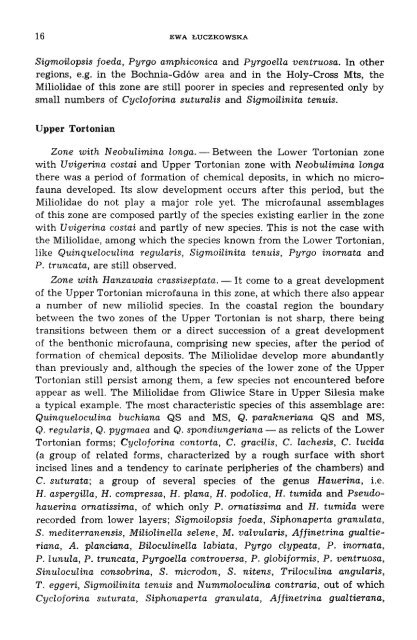MILIOLIDAE - Acta Palaeontologica Polonica
MILIOLIDAE - Acta Palaeontologica Polonica
MILIOLIDAE - Acta Palaeontologica Polonica
You also want an ePaper? Increase the reach of your titles
YUMPU automatically turns print PDFs into web optimized ePapers that Google loves.
16 EWA LUCZKOWSKA<br />
Sigmoilopsis foeda, Pyrgo amphiconica and Pyrgoella ventruosa. In other<br />
regions, e.g. in the Bochnia-Gd6w area and in the Holy-Cross Mts, the<br />
Miliolidae of this zone are still poorer in species and represented only by<br />
small numbers of Cycloforina suturalis and Sigmoilinita tenuis.<br />
Upper Tortonian<br />
Zone with Neobulimina longa. - Between the Lower Tortonian zone<br />
with Uvigerina costai and Upper Tortonian zone with Neobulimina longa<br />
there was a period of formation of chemical deposits, in which no microfauna<br />
developed. Its slow development occurs after this period, but the<br />
Miliolidae do not playa major role yet. The microfaunaI assemblages<br />
of this zone are composed partly of the species existing earlier in the zone<br />
with Uvigerina costai and partly of new species. This is not the case with<br />
the Miliolidae, among which the species known from the Lower Tortonian,<br />
like Quinqueloculina regularis, Sigmoilinita tenuis, Pyrgo inornata and<br />
P. truncata, are still observed.<br />
Zone with Hanzawaia crassiseptata. - It come to a great development<br />
of the Upper Tortonian microfauna in this zone, at which there also appear<br />
a number of new miliolid species. In the coastal region the boundary<br />
between the two zones of the Upper Tortonian is not sharp, there being<br />
transitions between them or a direct succession of a great development<br />
of the benthonic microfauna, comprising new species, after the period of<br />
formation of chemical deposits. The Miliolidae develop more abundantly<br />
than previously and, although the species of the lower zone of the Upper<br />
Tortonian still persist among them, a few species not encountered before<br />
appear as well. The Miliolidae from Gliwice Stare in Upper Silesia make<br />
a typical example. The most characteristic species of this assemblage are:<br />
Quinqueloculina buchiana QS and MS, Q. parakneriana QS and MS,<br />
Q. regularis, Q. pygmaea and Q. spondiungeriana - as relicts of the Lower<br />
Tortonian forms; Cycloforina contorta, C. gracilis, C. lachesis, C. lucida<br />
(a group of related forms, characterized by a rough surface with short<br />
incised lines and a tendency to carinate peripheries of the chambers) and<br />
C. suturata; a group of several species of the genus Hauerina, i.e.<br />
H. aspergilla, H. compressa, H. plana, H. podolica, H. tumida and Pseudohauerina<br />
ornatissima, of which only P. ornatissima and H. tumida were<br />
recorded from lower layers; Sigmoilopsis foeda, Siphonaperta granulata,<br />
S. mediterranensis, Miliolinella selene, M. valvularis, Affinetrina gualtieriana,<br />
A. planciana, Biloculinella labiata, Pyrgo clypeata, P. inornata,<br />
P. lunula, P. truncata, Pyrgoella controversa, P. globiformis, P. ventruosa,<br />
Sinuloculina consobrina, S. microdon, S. nitens, Triloculina angularis,<br />
T. eggeri, Sigmoilinita tenuis and Nummoloculina contraria, out of which<br />
Cycloforina suturata, Siphonaperta granulata, Affinetrina gualtierana,
















